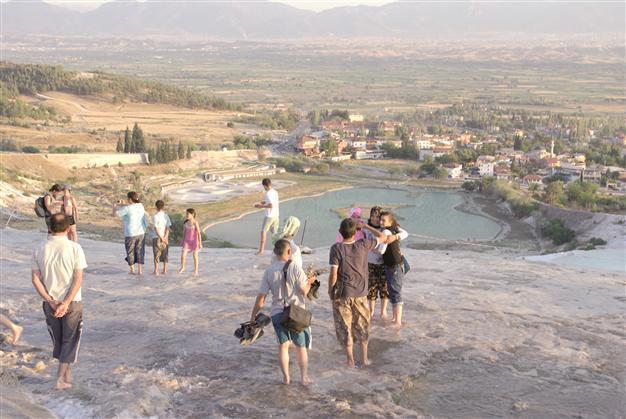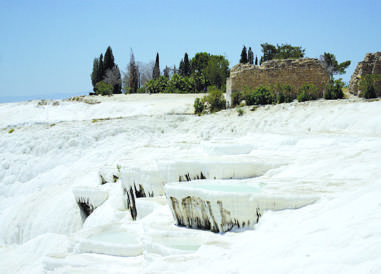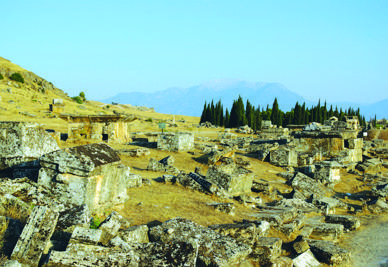More to Pamukkale than just ‘cotton’
WILCO VAN HERPEN

The most important thing when packing for Pamukkale is your sunglasses. My goodness, the light is so bright. A second crucial piece of your luggage is sunblock, and when I say sunblock, I mean BLOCK! The sunlight reflected by the travertine is so strong that if you walk around for a day without using anything, you might end up with third-degree sunburn. But this is about the most negative thing I will write about Pamukkale – whose name means cotton castle – because it is a beautiful place and is one of the highlights for anyone that goes to Turkey.

I clearly remember the stories of two Dutch friends who made a bicycle tour in Turkey. It must have been around 1987 when they decided to hit the road and ride around Turkey. When they arrived in Pamukkale, they were so surprised about these beautiful, snow-white, travertine pools and at the fact that you could walk around and, even more special, walk in these pools. There was no ticket office and no endless streams of tourists; no, they were all alone in this beautiful, virgin paradise.
Nowadays, the travertine pools are not as white as they used to be. One of the reasons might be the overwhelming number of tourists who visit Pamukkale every year. For that reason, some of the pools are closed to visitors. Another reason might be the watering system in Pamukkale. Whereas 30 or 40 years ago, the water ran freely and found its own way, nowadays there is a system that arranges the water flow into the pools. Compared to the past, fewer hotels still have their own pool and, according to special regulations, those pools are smaller than the ones they built in the past.
But still, in spite of all the tourists, Pamukkale is an impressive place to visit. (If you do not want to see so many tourists, this time of the year might be perfect for you.) The area of Pamukkale is not really a green lush area; the main street leading to the travertine is a typical Turkish road. But then, when you get out of your car and start walking around, there will be one surprise after another. If you ask me, I would recommend you stay at least two or three days here. There is enough to do and discover.
Most people only visit the Roman bath and the travertine pools, but there is so much more to see.

When I was there, I walked around the ancient city of Hierapolis and visited the Necropolis of Pamukkale. I love those places because you can wander around and be surprised about the variety of tombs that are seemingly scattered all over the place. Many tourists can’t resist climbing on the tombs, posing together with friends, and I have even seen some people eating lunch on the tombs. For me, a necropolis is a sacred place, as are all graveyards in the world. These are places to show your respect to those who have passed away, even if the tombs are empty. The tombs are more than 1,500 years old, so at least one should respect history and what remains of it. You can find the best examples of the sarcophagus in the museum. Some of them are as beautiful as the sarcophagi in the Mosaic Museum of Hatay.
So we have seen the Roman bath, the Travertine pools, the Necropolis and the museum. You might think it’s time to leave, but there are still a couple of interesting things you can see. Near Pamukkale are a couple of other places that are quite interesting. Whereas Pamukkale is like a bride in white on her wedding day, about eight kilometers away from Pamukkale, in Karahayıt, there is a brownish water spring with nice warm water (actually they call them the Red Springs of Karahayıt). You can have a mud bath or just enjoy the swimming pool that might not look too nice at first sight, but is wonderful once you are in the water. All those springs in an around Pamukkale have curing effects because of the minerals and metals in the water. But for a real water therapy, you need, of course, much more than one or two days. And nobody gives you a guarantee that you will get cured. The necropolis is full of people who went to Pamukkale to get cured but who did not make it…
Then there is the “piece de resistance.” A beautiful but small cave in Kaklık called the Kaklık Mağarası (Caves of Kaklık). Just a 30-minute ride away from Pamukkale, a new world opens up in front of your eyes. While most of the caves people visit are big caves, the Kaklık caves is a small cave but with its own charm. Green stone formations and algae give the cave its own signature. Here as well, the signature of the travertine is obvious, although it is not snow-white like in Pamukkale itself.
I had a great time when I was in Pamukkale and think that everybody who visits Turkey should visit this miraculous place. If you don’t see Pamukkale, you haven’t seen Turkey.
 The most important thing when packing for Pamukkale is your sunglasses. My goodness, the light is so bright. A second crucial piece of your luggage is sunblock, and when I say sunblock, I mean BLOCK! The sunlight reflected by the travertine is so strong that if you walk around for a day without using anything, you might end up with third-degree sunburn. But this is about the most negative thing I will write about Pamukkale – whose name means cotton castle – because it is a beautiful place and is one of the highlights for anyone that goes to Turkey.
The most important thing when packing for Pamukkale is your sunglasses. My goodness, the light is so bright. A second crucial piece of your luggage is sunblock, and when I say sunblock, I mean BLOCK! The sunlight reflected by the travertine is so strong that if you walk around for a day without using anything, you might end up with third-degree sunburn. But this is about the most negative thing I will write about Pamukkale – whose name means cotton castle – because it is a beautiful place and is one of the highlights for anyone that goes to Turkey.  I clearly remember the stories of two Dutch friends who made a bicycle tour in Turkey. It must have been around 1987 when they decided to hit the road and ride around Turkey. When they arrived in Pamukkale, they were so surprised about these beautiful, snow-white, travertine pools and at the fact that you could walk around and, even more special, walk in these pools. There was no ticket office and no endless streams of tourists; no, they were all alone in this beautiful, virgin paradise.
I clearly remember the stories of two Dutch friends who made a bicycle tour in Turkey. It must have been around 1987 when they decided to hit the road and ride around Turkey. When they arrived in Pamukkale, they were so surprised about these beautiful, snow-white, travertine pools and at the fact that you could walk around and, even more special, walk in these pools. There was no ticket office and no endless streams of tourists; no, they were all alone in this beautiful, virgin paradise.  When I was there, I walked around the ancient city of Hierapolis and visited the Necropolis of Pamukkale. I love those places because you can wander around and be surprised about the variety of tombs that are seemingly scattered all over the place. Many tourists can’t resist climbing on the tombs, posing together with friends, and I have even seen some people eating lunch on the tombs. For me, a necropolis is a sacred place, as are all graveyards in the world. These are places to show your respect to those who have passed away, even if the tombs are empty. The tombs are more than 1,500 years old, so at least one should respect history and what remains of it. You can find the best examples of the sarcophagus in the museum. Some of them are as beautiful as the sarcophagi in the Mosaic Museum of Hatay.
When I was there, I walked around the ancient city of Hierapolis and visited the Necropolis of Pamukkale. I love those places because you can wander around and be surprised about the variety of tombs that are seemingly scattered all over the place. Many tourists can’t resist climbing on the tombs, posing together with friends, and I have even seen some people eating lunch on the tombs. For me, a necropolis is a sacred place, as are all graveyards in the world. These are places to show your respect to those who have passed away, even if the tombs are empty. The tombs are more than 1,500 years old, so at least one should respect history and what remains of it. You can find the best examples of the sarcophagus in the museum. Some of them are as beautiful as the sarcophagi in the Mosaic Museum of Hatay.